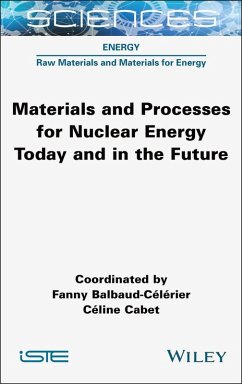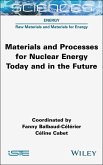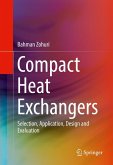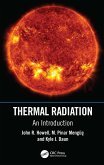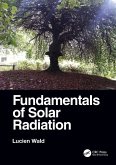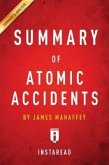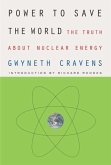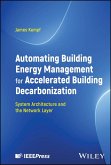Materials and Processes for Nuclear Energy Today and in the Future (eBook, ePUB)
Redaktion: Balbaud-Célérier, Fanny; Cabet, Céline
126,99 €
126,99 €
inkl. MwSt.
Sofort per Download lieferbar

0 °P sammeln
126,99 €
Als Download kaufen

126,99 €
inkl. MwSt.
Sofort per Download lieferbar

0 °P sammeln
Jetzt verschenken
Alle Infos zum eBook verschenken
126,99 €
inkl. MwSt.
Sofort per Download lieferbar
Alle Infos zum eBook verschenken

0 °P sammeln
Materials and Processes for Nuclear Energy Today and in the Future (eBook, ePUB)
Redaktion: Balbaud-Célérier, Fanny; Cabet, Céline
- Format: ePub
- Merkliste
- Auf die Merkliste
- Bewerten Bewerten
- Teilen
- Produkt teilen
- Produkterinnerung
- Produkterinnerung

Bitte loggen Sie sich zunächst in Ihr Kundenkonto ein oder registrieren Sie sich bei
bücher.de, um das eBook-Abo tolino select nutzen zu können.
Hier können Sie sich einloggen
Hier können Sie sich einloggen
Sie sind bereits eingeloggt. Klicken Sie auf 2. tolino select Abo, um fortzufahren.

Bitte loggen Sie sich zunächst in Ihr Kundenkonto ein oder registrieren Sie sich bei bücher.de, um das eBook-Abo tolino select nutzen zu können.
As a low carbon energy source, nuclear energy plays a reinforced role in a sustainable electricity mix. However, strengthening the share of nuclear energy implies the guarantee of safe, long-term operation of current systems and potentially the fostering of new constructions. Service life extension - as well as the design of future nuclear power plants - relies on the availability of robust and qualified structural materials, and their manufacturing processes. The science and engineering of materials are key in selecting robust material solutions and predicting aging mechanisms.
Materials…mehr
- Geräte: eReader
- mit Kopierschutz
- eBook Hilfe
- Größe: 36.37MB
Andere Kunden interessierten sich auch für
![Materials and Processes for Nuclear Energy Today and in the Future (eBook, PDF) Materials and Processes for Nuclear Energy Today and in the Future (eBook, PDF)]() Materials and Processes for Nuclear Energy Today and in the Future (eBook, PDF)126,99 €
Materials and Processes for Nuclear Energy Today and in the Future (eBook, PDF)126,99 €![Compact Heat Exchangers (eBook, ePUB) Compact Heat Exchangers (eBook, ePUB)]() Bahman ZohuriCompact Heat Exchangers (eBook, ePUB)169,95 €
Bahman ZohuriCompact Heat Exchangers (eBook, ePUB)169,95 €![Thermal Radiation (eBook, ePUB) Thermal Radiation (eBook, ePUB)]() John R. HowellThermal Radiation (eBook, ePUB)90,95 €
John R. HowellThermal Radiation (eBook, ePUB)90,95 €![Fundamentals of Solar Radiation (eBook, ePUB) Fundamentals of Solar Radiation (eBook, ePUB)]() Lucien WaldFundamentals of Solar Radiation (eBook, ePUB)47,95 €
Lucien WaldFundamentals of Solar Radiation (eBook, ePUB)47,95 €![Summary of AtomicAccidents (eBook, ePUB) Summary of AtomicAccidents (eBook, ePUB)]() Instaread SummariesSummary of AtomicAccidents (eBook, ePUB)2,99 €
Instaread SummariesSummary of AtomicAccidents (eBook, ePUB)2,99 €![Power to Save the World (eBook, ePUB) Power to Save the World (eBook, ePUB)]() Gwyneth CravensPower to Save the World (eBook, ePUB)4,99 €
Gwyneth CravensPower to Save the World (eBook, ePUB)4,99 €![Automating Building Energy Management for Accelerated Building Decarbonization: System Architecture and the Network Layer (eBook, ePUB) Automating Building Energy Management for Accelerated Building Decarbonization: System Architecture and the Network Layer (eBook, ePUB)]() James KempfAutomating Building Energy Management for Accelerated Building Decarbonization: System Architecture and the Network Layer (eBook, ePUB)96,99 €
James KempfAutomating Building Energy Management for Accelerated Building Decarbonization: System Architecture and the Network Layer (eBook, ePUB)96,99 €-
-
-
As a low carbon energy source, nuclear energy plays a reinforced role in a sustainable electricity mix. However, strengthening the share of nuclear energy implies the guarantee of safe, long-term operation of current systems and potentially the fostering of new constructions. Service life extension - as well as the design of future nuclear power plants - relies on the availability of robust and qualified structural materials, and their manufacturing processes. The science and engineering of materials are key in selecting robust material solutions and predicting aging mechanisms.
Materials and Processes for Nuclear Energy Today and in the Future reviews different reactor concepts and fuel management systems. Nuclear equipment has to maintain integrity under extreme conditions, such as high temperature, radiation, loads and/or corrosive environments. This book analyzes the requirements on components, and introduces reference solutions regarding materials and processes. It describes the materials' main properties, their limits and the current R&D trends. Lastly, innovations are discussed, such as materials with enhanced properties, advanced manufacturing or using AI.
Materials and Processes for Nuclear Energy Today and in the Future reviews different reactor concepts and fuel management systems. Nuclear equipment has to maintain integrity under extreme conditions, such as high temperature, radiation, loads and/or corrosive environments. This book analyzes the requirements on components, and introduces reference solutions regarding materials and processes. It describes the materials' main properties, their limits and the current R&D trends. Lastly, innovations are discussed, such as materials with enhanced properties, advanced manufacturing or using AI.
Dieser Download kann aus rechtlichen Gründen nur mit Rechnungsadresse in D ausgeliefert werden.
Produktdetails
- Produktdetails
- Verlag: John Wiley & Sons
- Seitenzahl: 547
- Erscheinungstermin: 8. Oktober 2024
- Englisch
- ISBN-13: 9781394325863
- Artikelnr.: 72245933
- Verlag: John Wiley & Sons
- Seitenzahl: 547
- Erscheinungstermin: 8. Oktober 2024
- Englisch
- ISBN-13: 9781394325863
- Artikelnr.: 72245933
- Herstellerkennzeichnung Die Herstellerinformationen sind derzeit nicht verfügbar.
Fanny Balbaud-Célérier is Head of the Corrosion and Materials Behavior research division. She is a Fellow and Research Director of the CEA in the field of corrosion and materials science, and specializes in nonaqueous corrosion phenomena. Céline Cabet has a PhD in Material Science and Engineering, and has worked for the French CEA since 2000. She holds the title of CEA Research Director, and is currently Deputy Head of the Advanced Materials and Processes Research division (SRMA).
Preface xi
Fanny BALBAUD-CÉLÉRIER and Céline CABET
Chapter 1 Materials and Processes for Light Water Reactors 1
Jean-Paul MASSOUD and Eric MOLINIÉ
1.1 Acronyms 1
1.2 Introduction with general description of the systems 3
1.2.1 Pressurized water reactor 3
1.2.2 Bwr 6
1.3 Requirements for materials 9
1.3.1 Brittle fracture 9
1.3.2 Corrosion 10
1.4 Material choices and basic properties 12
1.4.1 Carbon and LASs 14
1.4.2 Austenitic stainless steels 15
1.4.3 Nickel base alloys 16
1.4.4 Other materials 16
1.5 Fabrication and joining 19
1.5.1 Forging of Ferritic components: from ingot to component 20
1.5.2 Casting ... to forging 22
1.5.3 Forging of PWR SG tube bundle 22
1.5.4 Welding and cladding 23
1.5.5 Heat treatment 23
1.5.6 Manufacturing defects (links with fabrication) 24
1.5.7 Non-destructive testing (links with expected defects) 25
1.6 Main material limitations 27
1.6.1 BWRs 27
1.6.2 PWRs 28
1.6.3 Irradiation embrittlement 28
1.6.4 Thermal aging 34
1.6.5 Stress corrosion cracking 37
1.6.6 Flow-assisted corrosion 42
1.6.7 Other main possible mechanisms 43
1.7 Main material challenges and solutions under evaluation 48
1.7.1. Precautions to take during manufacturing to ensure the homogeneity
of the through wall property of huge components .. 48
1.7.2 Precautions to take during manufacturing to prevent or mitigate
in-service thermal aging, irradiation embrittlement, fatigue and stress
corrosion cracking 50
1.7.3 New possible fabrications under evaluation: hot isostatic pressing
and additive manufacturing 54
1.8 References 55
Chapter 2 Materials and Processes for Nuclear Fuel Reprocessing 57
Nathalie GRUET, Benoit GWINNER, Pierre LAGHOUTARIS, Beatriz PUGA,Pierre
FAUVET, Hervé ANTONY, Valentin ROHR, Eric CAVALETTI,Pierre CHAMBRETTE and
Laurent JUNOD
2.1 Introduction and general description of systems 57
2.1.1 Description of the process and the main functions 57
2.1.2 Description of aging conditions (temperature, nitric acid
concentration, etc.) 59
2.2 Requirements for materials 60
2.2.1 Functional requirements associated with the process: mechanical
resistance, corrosion resistance and erosion resistance 60
2.2.2 Regulatory context and industrial strategy 61
2.3 Current material choices, fabrication and joining 63
2.3.1 Current material choices 63
2.3.2 Fabrication and joining 65
2.4 Basic properties 66
2.4.1 Corrosion of austenitic stainless steels 66
2.4.2 Corrosion of zirconium 74
2.5 Parameters influencing corrosion 76
2.5.1 Corrosion products 77
2.5.2 Oxidizing ions 79
2.5.3 Halides (chlorides and fluorides) 83
2.5.4 Temperature and heat flux 85
2.5.5 Irradiation 86
2.5.6 Influence of the metallurgical state (welding) 87
2.6 Operating experience: some examples 88
2.6.1 Dissolver wheel 88
2.6.2 Fission product evaporator-concentrator machines 90
2.6.3 Zirconium thermosiphons 92
2.7 New developments 96
2.8 References 97
Chapter 3 Materials and Processes for Geological Disposal of High-level
Waste and Spent Fuel 107
Fraser KING
3.1 Introduction 107
3.2 Canister requirements 109
3.3 Choice of material, canister design and canister fabrication 114
3.4 Environmental conditions 117
3.5 Canister performance 122
3.5.1 Corrosion performance 122
3.5.2 Mechanical performance 129
3.5.3 Joint mechanical-corrosion performance 131
3.6 Lifetime prediction 132
3.7 Outlook 135
3.8 References 135
Chapter 4 Structural Materials for Sodium Cooled Fast Reactors 145
Hayato YAMASHITA and Tai ASAYAMA
4.1 Introduction 145
4.2 Requirements for structural materials 148
4.3 Development of structural materials and evaluation methods 151
4.3.1 Creep-fatigue evaluation methods 151
4.3.2 Improvement of creep-fatigue properties and materials 154
4.3.3 Creep-fatigue damage evaluation for 316FR steel and modified 9Cr-1Mo
steel 157
4.3.4 Effect of operating environment on creep-fatigue properties 159
4.4 Ongoing activities 165
4.5 Conclusion 166
4.6 References 166
Chapter 5 Materials and Processes for Heavy Liquid Metal Cooled Reactors
169
Serguei GAVRILOV
5.1 Introduction 169
5.2 Requirements for materials 176
5.3 Material choices and basic properties 178
5.4 Fabrication and joining 181
5.5 Main material limitations 182
5.5.1 Liquid metal corrosion 182
5.5.2 Liquid metal embrittlement 186
5.5.3 Corrosion fatigue and corrosion creep 187
5.5.4 Limitations for material qualification 188
5.6 Main material challenges and solutions under evaluation 189
5.7 References 193
Chapter 6 Materials and Processes for Molten Salts Reactors 197
Céline CABET, Yann DE CARLAN and Laure MARTINELLI
6.1 Introduction with general description of the systems 197
6.1.1 Background 198
6.1.2 MSR research emphasis 200
6.2 Requirements for materials 203
6.2.1 Graphite performance (thermal spectrum) 203
6.2.2 Neutron reflector (fast spectrum) 204
6.2.3 Structural materials 204
6.3 Legacy materials and basic properties 205
6.4 Main material limitations 207
6.4.1 Corrosion in molten fluorides 208
6.4.2 Corrosion in molten chlorides 212
6.4.3 Tellurium embrittlement 214
6.4.4 Irradiation embrittlement 215
6.5 Mitigation of corrosion by salt purification and chemical control 216
6.5.1 Molten fluorides 217
6.5.2 Molten chlorides 218
6.6 Main material challenges and solutions under evaluation 218
6.7 References 219
Chapter 7 Materials and Processes for Fusion Reactors 225
Giacomo AIELLO
7.1 Introduction and general description of the systems 225
7.2 Requirements for materials 228
7.2.1 Requirements for the structural material of the BB system 228
7.2.2 Requirements for the materials of the Divertor system 230
7.3 Material choices and basic properties 232
7.3.1 EUROFER97 as structural material for the BB 232
7.3.2 Tungsten and copper-chromium-zirconium as armor and heat sink
materials for the Divertor targets 238
7.4 Fabrication and joining 246
7.4.1 Manufacturing techniques for the BB 246
7.4.2 Manufacturing techniques for the Divertor targets 249
7.5 Main material limitations and solutions under evaluation 250
7.5.1 Limits for structural material EUROFER97 and development of
advanced/risk mitigation steels 251
7.5.2 Advanced armor and heat sink materials for the Divertor targets 254
7.6 References 256
Chapter 8 Advanced Materials: Ceramics and Composite Materials 261
James BRAUN
8.1 Introduction 261
8.2 Current interest in nuclear systems 263
8.3 Manufacturing and joining 266
8.4 Material properties 269
8.5 Main challenges and solutions under evaluation 271
8.6 References 272
Chapter 9 Advanced Materials: Oxide-Dispersion Strengthened Steels 279
Satoshi OHTSUKA, Takashi TANNO, Yasuhide YANO and Takeji KAITO
9.1 General introduction to the ODS 279
9.2 Actual interest in nuclear systems 280
9.3 Fabrication and joining 283
9.4 Material properties 286
9.5 Main material challenges and solutions under evaluation 292
9.6 References 293
Chapter 10 Materials Discovery 299
Andrea JOKISAARI, Cheng SUN and Jian GAN
10.1 Materials discovery - numerical design 299
10.1.1 What is materials discovery and is it needed in the nuclear
industry? 299
10.1.2 Historical perspective 300
10.1.3 Modern approach 302
10.1.4 Future needs 307
10.2 Materials discovery - advanced manufacturing processes 309
10.2.1 AM technologies 309
10.2.2 AM materials under nuclear environments 312
10.2.3 Challenges of AM processes for nuclear materials 316
10.2.4 Summary 318
10.3 Materials discovery - high-throughput characterization 318
10.3.1 Material fabrication and sample preparation 319
10.3.2 Microstructural characterization 320
10.3.3 High-throughput mechanical and corrosion property evaluation 322
10.3.4 High-throughput irradiation and characterization 325
10.4 Summary 327
10.5 References 328
List of Authors 337
Index 341
Fanny BALBAUD-CÉLÉRIER and Céline CABET
Chapter 1 Materials and Processes for Light Water Reactors 1
Jean-Paul MASSOUD and Eric MOLINIÉ
1.1 Acronyms 1
1.2 Introduction with general description of the systems 3
1.2.1 Pressurized water reactor 3
1.2.2 Bwr 6
1.3 Requirements for materials 9
1.3.1 Brittle fracture 9
1.3.2 Corrosion 10
1.4 Material choices and basic properties 12
1.4.1 Carbon and LASs 14
1.4.2 Austenitic stainless steels 15
1.4.3 Nickel base alloys 16
1.4.4 Other materials 16
1.5 Fabrication and joining 19
1.5.1 Forging of Ferritic components: from ingot to component 20
1.5.2 Casting ... to forging 22
1.5.3 Forging of PWR SG tube bundle 22
1.5.4 Welding and cladding 23
1.5.5 Heat treatment 23
1.5.6 Manufacturing defects (links with fabrication) 24
1.5.7 Non-destructive testing (links with expected defects) 25
1.6 Main material limitations 27
1.6.1 BWRs 27
1.6.2 PWRs 28
1.6.3 Irradiation embrittlement 28
1.6.4 Thermal aging 34
1.6.5 Stress corrosion cracking 37
1.6.6 Flow-assisted corrosion 42
1.6.7 Other main possible mechanisms 43
1.7 Main material challenges and solutions under evaluation 48
1.7.1. Precautions to take during manufacturing to ensure the homogeneity
of the through wall property of huge components .. 48
1.7.2 Precautions to take during manufacturing to prevent or mitigate
in-service thermal aging, irradiation embrittlement, fatigue and stress
corrosion cracking 50
1.7.3 New possible fabrications under evaluation: hot isostatic pressing
and additive manufacturing 54
1.8 References 55
Chapter 2 Materials and Processes for Nuclear Fuel Reprocessing 57
Nathalie GRUET, Benoit GWINNER, Pierre LAGHOUTARIS, Beatriz PUGA,Pierre
FAUVET, Hervé ANTONY, Valentin ROHR, Eric CAVALETTI,Pierre CHAMBRETTE and
Laurent JUNOD
2.1 Introduction and general description of systems 57
2.1.1 Description of the process and the main functions 57
2.1.2 Description of aging conditions (temperature, nitric acid
concentration, etc.) 59
2.2 Requirements for materials 60
2.2.1 Functional requirements associated with the process: mechanical
resistance, corrosion resistance and erosion resistance 60
2.2.2 Regulatory context and industrial strategy 61
2.3 Current material choices, fabrication and joining 63
2.3.1 Current material choices 63
2.3.2 Fabrication and joining 65
2.4 Basic properties 66
2.4.1 Corrosion of austenitic stainless steels 66
2.4.2 Corrosion of zirconium 74
2.5 Parameters influencing corrosion 76
2.5.1 Corrosion products 77
2.5.2 Oxidizing ions 79
2.5.3 Halides (chlorides and fluorides) 83
2.5.4 Temperature and heat flux 85
2.5.5 Irradiation 86
2.5.6 Influence of the metallurgical state (welding) 87
2.6 Operating experience: some examples 88
2.6.1 Dissolver wheel 88
2.6.2 Fission product evaporator-concentrator machines 90
2.6.3 Zirconium thermosiphons 92
2.7 New developments 96
2.8 References 97
Chapter 3 Materials and Processes for Geological Disposal of High-level
Waste and Spent Fuel 107
Fraser KING
3.1 Introduction 107
3.2 Canister requirements 109
3.3 Choice of material, canister design and canister fabrication 114
3.4 Environmental conditions 117
3.5 Canister performance 122
3.5.1 Corrosion performance 122
3.5.2 Mechanical performance 129
3.5.3 Joint mechanical-corrosion performance 131
3.6 Lifetime prediction 132
3.7 Outlook 135
3.8 References 135
Chapter 4 Structural Materials for Sodium Cooled Fast Reactors 145
Hayato YAMASHITA and Tai ASAYAMA
4.1 Introduction 145
4.2 Requirements for structural materials 148
4.3 Development of structural materials and evaluation methods 151
4.3.1 Creep-fatigue evaluation methods 151
4.3.2 Improvement of creep-fatigue properties and materials 154
4.3.3 Creep-fatigue damage evaluation for 316FR steel and modified 9Cr-1Mo
steel 157
4.3.4 Effect of operating environment on creep-fatigue properties 159
4.4 Ongoing activities 165
4.5 Conclusion 166
4.6 References 166
Chapter 5 Materials and Processes for Heavy Liquid Metal Cooled Reactors
169
Serguei GAVRILOV
5.1 Introduction 169
5.2 Requirements for materials 176
5.3 Material choices and basic properties 178
5.4 Fabrication and joining 181
5.5 Main material limitations 182
5.5.1 Liquid metal corrosion 182
5.5.2 Liquid metal embrittlement 186
5.5.3 Corrosion fatigue and corrosion creep 187
5.5.4 Limitations for material qualification 188
5.6 Main material challenges and solutions under evaluation 189
5.7 References 193
Chapter 6 Materials and Processes for Molten Salts Reactors 197
Céline CABET, Yann DE CARLAN and Laure MARTINELLI
6.1 Introduction with general description of the systems 197
6.1.1 Background 198
6.1.2 MSR research emphasis 200
6.2 Requirements for materials 203
6.2.1 Graphite performance (thermal spectrum) 203
6.2.2 Neutron reflector (fast spectrum) 204
6.2.3 Structural materials 204
6.3 Legacy materials and basic properties 205
6.4 Main material limitations 207
6.4.1 Corrosion in molten fluorides 208
6.4.2 Corrosion in molten chlorides 212
6.4.3 Tellurium embrittlement 214
6.4.4 Irradiation embrittlement 215
6.5 Mitigation of corrosion by salt purification and chemical control 216
6.5.1 Molten fluorides 217
6.5.2 Molten chlorides 218
6.6 Main material challenges and solutions under evaluation 218
6.7 References 219
Chapter 7 Materials and Processes for Fusion Reactors 225
Giacomo AIELLO
7.1 Introduction and general description of the systems 225
7.2 Requirements for materials 228
7.2.1 Requirements for the structural material of the BB system 228
7.2.2 Requirements for the materials of the Divertor system 230
7.3 Material choices and basic properties 232
7.3.1 EUROFER97 as structural material for the BB 232
7.3.2 Tungsten and copper-chromium-zirconium as armor and heat sink
materials for the Divertor targets 238
7.4 Fabrication and joining 246
7.4.1 Manufacturing techniques for the BB 246
7.4.2 Manufacturing techniques for the Divertor targets 249
7.5 Main material limitations and solutions under evaluation 250
7.5.1 Limits for structural material EUROFER97 and development of
advanced/risk mitigation steels 251
7.5.2 Advanced armor and heat sink materials for the Divertor targets 254
7.6 References 256
Chapter 8 Advanced Materials: Ceramics and Composite Materials 261
James BRAUN
8.1 Introduction 261
8.2 Current interest in nuclear systems 263
8.3 Manufacturing and joining 266
8.4 Material properties 269
8.5 Main challenges and solutions under evaluation 271
8.6 References 272
Chapter 9 Advanced Materials: Oxide-Dispersion Strengthened Steels 279
Satoshi OHTSUKA, Takashi TANNO, Yasuhide YANO and Takeji KAITO
9.1 General introduction to the ODS 279
9.2 Actual interest in nuclear systems 280
9.3 Fabrication and joining 283
9.4 Material properties 286
9.5 Main material challenges and solutions under evaluation 292
9.6 References 293
Chapter 10 Materials Discovery 299
Andrea JOKISAARI, Cheng SUN and Jian GAN
10.1 Materials discovery - numerical design 299
10.1.1 What is materials discovery and is it needed in the nuclear
industry? 299
10.1.2 Historical perspective 300
10.1.3 Modern approach 302
10.1.4 Future needs 307
10.2 Materials discovery - advanced manufacturing processes 309
10.2.1 AM technologies 309
10.2.2 AM materials under nuclear environments 312
10.2.3 Challenges of AM processes for nuclear materials 316
10.2.4 Summary 318
10.3 Materials discovery - high-throughput characterization 318
10.3.1 Material fabrication and sample preparation 319
10.3.2 Microstructural characterization 320
10.3.3 High-throughput mechanical and corrosion property evaluation 322
10.3.4 High-throughput irradiation and characterization 325
10.4 Summary 327
10.5 References 328
List of Authors 337
Index 341
Preface xi
Fanny BALBAUD-CÉLÉRIER and Céline CABET
Chapter 1 Materials and Processes for Light Water Reactors 1
Jean-Paul MASSOUD and Eric MOLINIÉ
1.1 Acronyms 1
1.2 Introduction with general description of the systems 3
1.2.1 Pressurized water reactor 3
1.2.2 Bwr 6
1.3 Requirements for materials 9
1.3.1 Brittle fracture 9
1.3.2 Corrosion 10
1.4 Material choices and basic properties 12
1.4.1 Carbon and LASs 14
1.4.2 Austenitic stainless steels 15
1.4.3 Nickel base alloys 16
1.4.4 Other materials 16
1.5 Fabrication and joining 19
1.5.1 Forging of Ferritic components: from ingot to component 20
1.5.2 Casting ... to forging 22
1.5.3 Forging of PWR SG tube bundle 22
1.5.4 Welding and cladding 23
1.5.5 Heat treatment 23
1.5.6 Manufacturing defects (links with fabrication) 24
1.5.7 Non-destructive testing (links with expected defects) 25
1.6 Main material limitations 27
1.6.1 BWRs 27
1.6.2 PWRs 28
1.6.3 Irradiation embrittlement 28
1.6.4 Thermal aging 34
1.6.5 Stress corrosion cracking 37
1.6.6 Flow-assisted corrosion 42
1.6.7 Other main possible mechanisms 43
1.7 Main material challenges and solutions under evaluation 48
1.7.1. Precautions to take during manufacturing to ensure the homogeneity
of the through wall property of huge components .. 48
1.7.2 Precautions to take during manufacturing to prevent or mitigate
in-service thermal aging, irradiation embrittlement, fatigue and stress
corrosion cracking 50
1.7.3 New possible fabrications under evaluation: hot isostatic pressing
and additive manufacturing 54
1.8 References 55
Chapter 2 Materials and Processes for Nuclear Fuel Reprocessing 57
Nathalie GRUET, Benoit GWINNER, Pierre LAGHOUTARIS, Beatriz PUGA,Pierre
FAUVET, Hervé ANTONY, Valentin ROHR, Eric CAVALETTI,Pierre CHAMBRETTE and
Laurent JUNOD
2.1 Introduction and general description of systems 57
2.1.1 Description of the process and the main functions 57
2.1.2 Description of aging conditions (temperature, nitric acid
concentration, etc.) 59
2.2 Requirements for materials 60
2.2.1 Functional requirements associated with the process: mechanical
resistance, corrosion resistance and erosion resistance 60
2.2.2 Regulatory context and industrial strategy 61
2.3 Current material choices, fabrication and joining 63
2.3.1 Current material choices 63
2.3.2 Fabrication and joining 65
2.4 Basic properties 66
2.4.1 Corrosion of austenitic stainless steels 66
2.4.2 Corrosion of zirconium 74
2.5 Parameters influencing corrosion 76
2.5.1 Corrosion products 77
2.5.2 Oxidizing ions 79
2.5.3 Halides (chlorides and fluorides) 83
2.5.4 Temperature and heat flux 85
2.5.5 Irradiation 86
2.5.6 Influence of the metallurgical state (welding) 87
2.6 Operating experience: some examples 88
2.6.1 Dissolver wheel 88
2.6.2 Fission product evaporator-concentrator machines 90
2.6.3 Zirconium thermosiphons 92
2.7 New developments 96
2.8 References 97
Chapter 3 Materials and Processes for Geological Disposal of High-level
Waste and Spent Fuel 107
Fraser KING
3.1 Introduction 107
3.2 Canister requirements 109
3.3 Choice of material, canister design and canister fabrication 114
3.4 Environmental conditions 117
3.5 Canister performance 122
3.5.1 Corrosion performance 122
3.5.2 Mechanical performance 129
3.5.3 Joint mechanical-corrosion performance 131
3.6 Lifetime prediction 132
3.7 Outlook 135
3.8 References 135
Chapter 4 Structural Materials for Sodium Cooled Fast Reactors 145
Hayato YAMASHITA and Tai ASAYAMA
4.1 Introduction 145
4.2 Requirements for structural materials 148
4.3 Development of structural materials and evaluation methods 151
4.3.1 Creep-fatigue evaluation methods 151
4.3.2 Improvement of creep-fatigue properties and materials 154
4.3.3 Creep-fatigue damage evaluation for 316FR steel and modified 9Cr-1Mo
steel 157
4.3.4 Effect of operating environment on creep-fatigue properties 159
4.4 Ongoing activities 165
4.5 Conclusion 166
4.6 References 166
Chapter 5 Materials and Processes for Heavy Liquid Metal Cooled Reactors
169
Serguei GAVRILOV
5.1 Introduction 169
5.2 Requirements for materials 176
5.3 Material choices and basic properties 178
5.4 Fabrication and joining 181
5.5 Main material limitations 182
5.5.1 Liquid metal corrosion 182
5.5.2 Liquid metal embrittlement 186
5.5.3 Corrosion fatigue and corrosion creep 187
5.5.4 Limitations for material qualification 188
5.6 Main material challenges and solutions under evaluation 189
5.7 References 193
Chapter 6 Materials and Processes for Molten Salts Reactors 197
Céline CABET, Yann DE CARLAN and Laure MARTINELLI
6.1 Introduction with general description of the systems 197
6.1.1 Background 198
6.1.2 MSR research emphasis 200
6.2 Requirements for materials 203
6.2.1 Graphite performance (thermal spectrum) 203
6.2.2 Neutron reflector (fast spectrum) 204
6.2.3 Structural materials 204
6.3 Legacy materials and basic properties 205
6.4 Main material limitations 207
6.4.1 Corrosion in molten fluorides 208
6.4.2 Corrosion in molten chlorides 212
6.4.3 Tellurium embrittlement 214
6.4.4 Irradiation embrittlement 215
6.5 Mitigation of corrosion by salt purification and chemical control 216
6.5.1 Molten fluorides 217
6.5.2 Molten chlorides 218
6.6 Main material challenges and solutions under evaluation 218
6.7 References 219
Chapter 7 Materials and Processes for Fusion Reactors 225
Giacomo AIELLO
7.1 Introduction and general description of the systems 225
7.2 Requirements for materials 228
7.2.1 Requirements for the structural material of the BB system 228
7.2.2 Requirements for the materials of the Divertor system 230
7.3 Material choices and basic properties 232
7.3.1 EUROFER97 as structural material for the BB 232
7.3.2 Tungsten and copper-chromium-zirconium as armor and heat sink
materials for the Divertor targets 238
7.4 Fabrication and joining 246
7.4.1 Manufacturing techniques for the BB 246
7.4.2 Manufacturing techniques for the Divertor targets 249
7.5 Main material limitations and solutions under evaluation 250
7.5.1 Limits for structural material EUROFER97 and development of
advanced/risk mitigation steels 251
7.5.2 Advanced armor and heat sink materials for the Divertor targets 254
7.6 References 256
Chapter 8 Advanced Materials: Ceramics and Composite Materials 261
James BRAUN
8.1 Introduction 261
8.2 Current interest in nuclear systems 263
8.3 Manufacturing and joining 266
8.4 Material properties 269
8.5 Main challenges and solutions under evaluation 271
8.6 References 272
Chapter 9 Advanced Materials: Oxide-Dispersion Strengthened Steels 279
Satoshi OHTSUKA, Takashi TANNO, Yasuhide YANO and Takeji KAITO
9.1 General introduction to the ODS 279
9.2 Actual interest in nuclear systems 280
9.3 Fabrication and joining 283
9.4 Material properties 286
9.5 Main material challenges and solutions under evaluation 292
9.6 References 293
Chapter 10 Materials Discovery 299
Andrea JOKISAARI, Cheng SUN and Jian GAN
10.1 Materials discovery - numerical design 299
10.1.1 What is materials discovery and is it needed in the nuclear
industry? 299
10.1.2 Historical perspective 300
10.1.3 Modern approach 302
10.1.4 Future needs 307
10.2 Materials discovery - advanced manufacturing processes 309
10.2.1 AM technologies 309
10.2.2 AM materials under nuclear environments 312
10.2.3 Challenges of AM processes for nuclear materials 316
10.2.4 Summary 318
10.3 Materials discovery - high-throughput characterization 318
10.3.1 Material fabrication and sample preparation 319
10.3.2 Microstructural characterization 320
10.3.3 High-throughput mechanical and corrosion property evaluation 322
10.3.4 High-throughput irradiation and characterization 325
10.4 Summary 327
10.5 References 328
List of Authors 337
Index 341
Fanny BALBAUD-CÉLÉRIER and Céline CABET
Chapter 1 Materials and Processes for Light Water Reactors 1
Jean-Paul MASSOUD and Eric MOLINIÉ
1.1 Acronyms 1
1.2 Introduction with general description of the systems 3
1.2.1 Pressurized water reactor 3
1.2.2 Bwr 6
1.3 Requirements for materials 9
1.3.1 Brittle fracture 9
1.3.2 Corrosion 10
1.4 Material choices and basic properties 12
1.4.1 Carbon and LASs 14
1.4.2 Austenitic stainless steels 15
1.4.3 Nickel base alloys 16
1.4.4 Other materials 16
1.5 Fabrication and joining 19
1.5.1 Forging of Ferritic components: from ingot to component 20
1.5.2 Casting ... to forging 22
1.5.3 Forging of PWR SG tube bundle 22
1.5.4 Welding and cladding 23
1.5.5 Heat treatment 23
1.5.6 Manufacturing defects (links with fabrication) 24
1.5.7 Non-destructive testing (links with expected defects) 25
1.6 Main material limitations 27
1.6.1 BWRs 27
1.6.2 PWRs 28
1.6.3 Irradiation embrittlement 28
1.6.4 Thermal aging 34
1.6.5 Stress corrosion cracking 37
1.6.6 Flow-assisted corrosion 42
1.6.7 Other main possible mechanisms 43
1.7 Main material challenges and solutions under evaluation 48
1.7.1. Precautions to take during manufacturing to ensure the homogeneity
of the through wall property of huge components .. 48
1.7.2 Precautions to take during manufacturing to prevent or mitigate
in-service thermal aging, irradiation embrittlement, fatigue and stress
corrosion cracking 50
1.7.3 New possible fabrications under evaluation: hot isostatic pressing
and additive manufacturing 54
1.8 References 55
Chapter 2 Materials and Processes for Nuclear Fuel Reprocessing 57
Nathalie GRUET, Benoit GWINNER, Pierre LAGHOUTARIS, Beatriz PUGA,Pierre
FAUVET, Hervé ANTONY, Valentin ROHR, Eric CAVALETTI,Pierre CHAMBRETTE and
Laurent JUNOD
2.1 Introduction and general description of systems 57
2.1.1 Description of the process and the main functions 57
2.1.2 Description of aging conditions (temperature, nitric acid
concentration, etc.) 59
2.2 Requirements for materials 60
2.2.1 Functional requirements associated with the process: mechanical
resistance, corrosion resistance and erosion resistance 60
2.2.2 Regulatory context and industrial strategy 61
2.3 Current material choices, fabrication and joining 63
2.3.1 Current material choices 63
2.3.2 Fabrication and joining 65
2.4 Basic properties 66
2.4.1 Corrosion of austenitic stainless steels 66
2.4.2 Corrosion of zirconium 74
2.5 Parameters influencing corrosion 76
2.5.1 Corrosion products 77
2.5.2 Oxidizing ions 79
2.5.3 Halides (chlorides and fluorides) 83
2.5.4 Temperature and heat flux 85
2.5.5 Irradiation 86
2.5.6 Influence of the metallurgical state (welding) 87
2.6 Operating experience: some examples 88
2.6.1 Dissolver wheel 88
2.6.2 Fission product evaporator-concentrator machines 90
2.6.3 Zirconium thermosiphons 92
2.7 New developments 96
2.8 References 97
Chapter 3 Materials and Processes for Geological Disposal of High-level
Waste and Spent Fuel 107
Fraser KING
3.1 Introduction 107
3.2 Canister requirements 109
3.3 Choice of material, canister design and canister fabrication 114
3.4 Environmental conditions 117
3.5 Canister performance 122
3.5.1 Corrosion performance 122
3.5.2 Mechanical performance 129
3.5.3 Joint mechanical-corrosion performance 131
3.6 Lifetime prediction 132
3.7 Outlook 135
3.8 References 135
Chapter 4 Structural Materials for Sodium Cooled Fast Reactors 145
Hayato YAMASHITA and Tai ASAYAMA
4.1 Introduction 145
4.2 Requirements for structural materials 148
4.3 Development of structural materials and evaluation methods 151
4.3.1 Creep-fatigue evaluation methods 151
4.3.2 Improvement of creep-fatigue properties and materials 154
4.3.3 Creep-fatigue damage evaluation for 316FR steel and modified 9Cr-1Mo
steel 157
4.3.4 Effect of operating environment on creep-fatigue properties 159
4.4 Ongoing activities 165
4.5 Conclusion 166
4.6 References 166
Chapter 5 Materials and Processes for Heavy Liquid Metal Cooled Reactors
169
Serguei GAVRILOV
5.1 Introduction 169
5.2 Requirements for materials 176
5.3 Material choices and basic properties 178
5.4 Fabrication and joining 181
5.5 Main material limitations 182
5.5.1 Liquid metal corrosion 182
5.5.2 Liquid metal embrittlement 186
5.5.3 Corrosion fatigue and corrosion creep 187
5.5.4 Limitations for material qualification 188
5.6 Main material challenges and solutions under evaluation 189
5.7 References 193
Chapter 6 Materials and Processes for Molten Salts Reactors 197
Céline CABET, Yann DE CARLAN and Laure MARTINELLI
6.1 Introduction with general description of the systems 197
6.1.1 Background 198
6.1.2 MSR research emphasis 200
6.2 Requirements for materials 203
6.2.1 Graphite performance (thermal spectrum) 203
6.2.2 Neutron reflector (fast spectrum) 204
6.2.3 Structural materials 204
6.3 Legacy materials and basic properties 205
6.4 Main material limitations 207
6.4.1 Corrosion in molten fluorides 208
6.4.2 Corrosion in molten chlorides 212
6.4.3 Tellurium embrittlement 214
6.4.4 Irradiation embrittlement 215
6.5 Mitigation of corrosion by salt purification and chemical control 216
6.5.1 Molten fluorides 217
6.5.2 Molten chlorides 218
6.6 Main material challenges and solutions under evaluation 218
6.7 References 219
Chapter 7 Materials and Processes for Fusion Reactors 225
Giacomo AIELLO
7.1 Introduction and general description of the systems 225
7.2 Requirements for materials 228
7.2.1 Requirements for the structural material of the BB system 228
7.2.2 Requirements for the materials of the Divertor system 230
7.3 Material choices and basic properties 232
7.3.1 EUROFER97 as structural material for the BB 232
7.3.2 Tungsten and copper-chromium-zirconium as armor and heat sink
materials for the Divertor targets 238
7.4 Fabrication and joining 246
7.4.1 Manufacturing techniques for the BB 246
7.4.2 Manufacturing techniques for the Divertor targets 249
7.5 Main material limitations and solutions under evaluation 250
7.5.1 Limits for structural material EUROFER97 and development of
advanced/risk mitigation steels 251
7.5.2 Advanced armor and heat sink materials for the Divertor targets 254
7.6 References 256
Chapter 8 Advanced Materials: Ceramics and Composite Materials 261
James BRAUN
8.1 Introduction 261
8.2 Current interest in nuclear systems 263
8.3 Manufacturing and joining 266
8.4 Material properties 269
8.5 Main challenges and solutions under evaluation 271
8.6 References 272
Chapter 9 Advanced Materials: Oxide-Dispersion Strengthened Steels 279
Satoshi OHTSUKA, Takashi TANNO, Yasuhide YANO and Takeji KAITO
9.1 General introduction to the ODS 279
9.2 Actual interest in nuclear systems 280
9.3 Fabrication and joining 283
9.4 Material properties 286
9.5 Main material challenges and solutions under evaluation 292
9.6 References 293
Chapter 10 Materials Discovery 299
Andrea JOKISAARI, Cheng SUN and Jian GAN
10.1 Materials discovery - numerical design 299
10.1.1 What is materials discovery and is it needed in the nuclear
industry? 299
10.1.2 Historical perspective 300
10.1.3 Modern approach 302
10.1.4 Future needs 307
10.2 Materials discovery - advanced manufacturing processes 309
10.2.1 AM technologies 309
10.2.2 AM materials under nuclear environments 312
10.2.3 Challenges of AM processes for nuclear materials 316
10.2.4 Summary 318
10.3 Materials discovery - high-throughput characterization 318
10.3.1 Material fabrication and sample preparation 319
10.3.2 Microstructural characterization 320
10.3.3 High-throughput mechanical and corrosion property evaluation 322
10.3.4 High-throughput irradiation and characterization 325
10.4 Summary 327
10.5 References 328
List of Authors 337
Index 341
